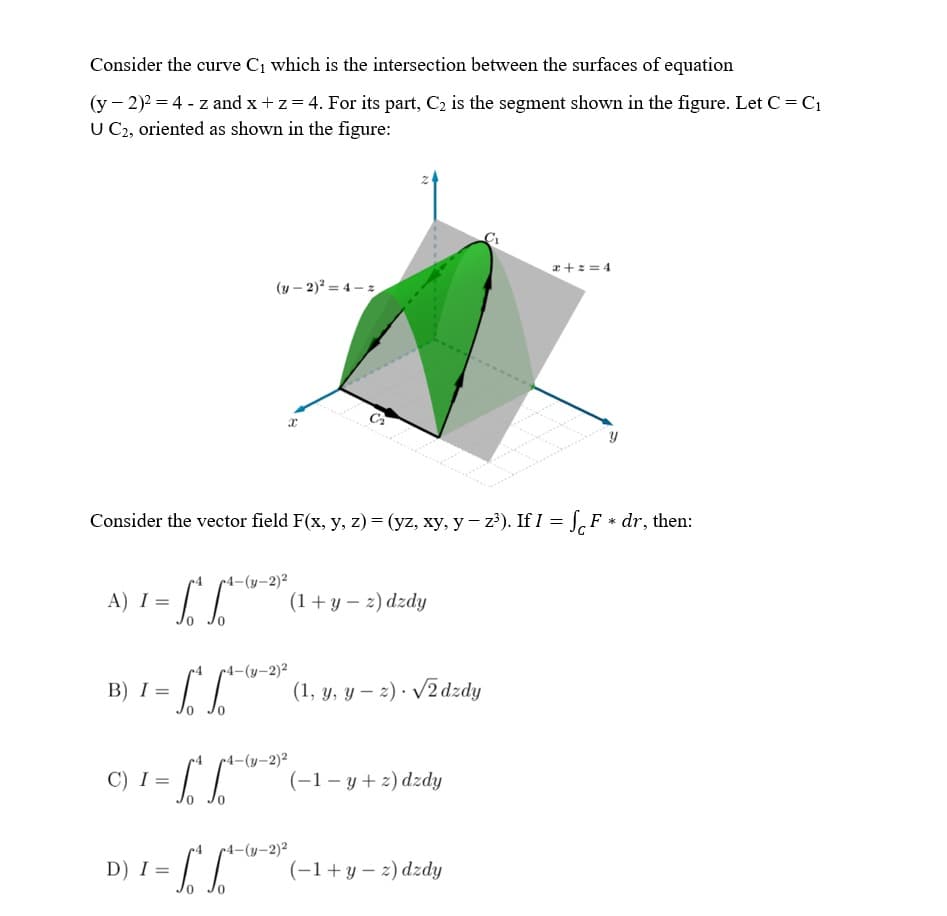Consider the curve C1 which is the intersection between the surfaces of equation (y - 2)2 = 4 - z and x + z= 4. For its part, C2 is the segment shown in the figure. Let C= C1 U C2, oriented as shown in the figure: a +: = 4 (y – 2)? = 4 – z Consider the vector field F(x, y, z) = (yz, xy, y - z³). If I = F * dr, then: r4 4-(y-2)2 A) I = (1+y – 2) dzdy r4-(y-2)² B) I = (1, y, y – 2) · /2 dzdy r4-(y-2)² C) I = (-1- y + 2) dzdy r4 4-(y-2)2 D) I = (-1+y – 2) dzdy
Consider the curve C1 which is the intersection between the surfaces of equation (y - 2)2 = 4 - z and x + z= 4. For its part, C2 is the segment shown in the figure. Let C= C1 U C2, oriented as shown in the figure: a +: = 4 (y – 2)? = 4 – z Consider the vector field F(x, y, z) = (yz, xy, y - z³). If I = F * dr, then: r4 4-(y-2)2 A) I = (1+y – 2) dzdy r4-(y-2)² B) I = (1, y, y – 2) · /2 dzdy r4-(y-2)² C) I = (-1- y + 2) dzdy r4 4-(y-2)2 D) I = (-1+y – 2) dzdy
Algebra & Trigonometry with Analytic Geometry
13th Edition
ISBN:9781133382119
Author:Swokowski
Publisher:Swokowski
Chapter11: Topics From Analytic Geometry
Section: Chapter Questions
Problem 18T
Related questions
Question
This is a calculation problem, please reply as soon as possible, thank you.

Transcribed Image Text:Consider the curve C1 which is the intersection between the surfaces of equation
(y - 2)2 = 4 - z and x + z= 4. For its part, C2 is the segment shown in the figure. Let C= C1
U C2, oriented as shown in the figure:
a +z = 4
(y – 2)? = 4 – z
Consider the vector field F(x, y, z) = (yz, xy, y– z?). If I = S, F * dr, then:
r4 4-(y-2)2
A) I =
(1+y – 2) dzdy
0.
r4-(y-2)²
B) I =
(1, y, y – 2) · /2dzdy
•4-(y-2)²
C) I =
(-1– y + 2) dzdy
r4 4-(y-2)2
D) I =
(-1+y – 2) dzdy
Expert Solution
This question has been solved!
Explore an expertly crafted, step-by-step solution for a thorough understanding of key concepts.
Step by step
Solved in 2 steps with 2 images

Recommended textbooks for you

Algebra & Trigonometry with Analytic Geometry
Algebra
ISBN:
9781133382119
Author:
Swokowski
Publisher:
Cengage

Algebra & Trigonometry with Analytic Geometry
Algebra
ISBN:
9781133382119
Author:
Swokowski
Publisher:
Cengage